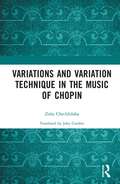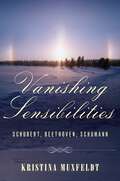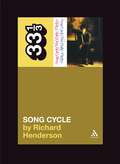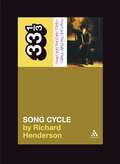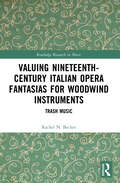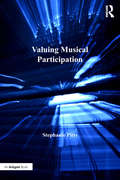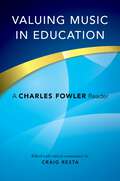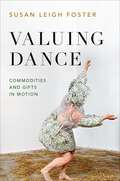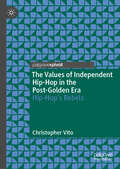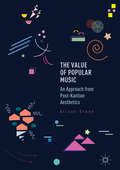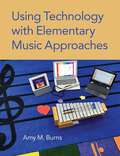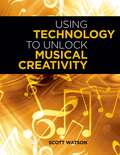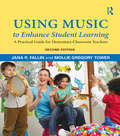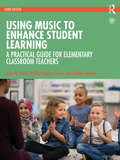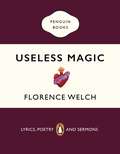- Table View
- List View
Variations and Variation Technique in the Music of Chopin
by Zofia ChechlińskaWhile Chopin composed only a few works in variation form, he employed variations and variation technique in the majority of his works. Multiple modified repetitions of musical units on different levels of a work are so typical of Chopin’s works that this may be considered one of the chief determinants of his style. Focusing on a broad range of Chopin’s works, this book explores the extent to which Chopin’s oeuvre is suffused with variations, the role that variation technique plays in his work, to what extent it interacts with other techniques for developing and modifying musical material, and how the variation technique itself evolved. Beginning with a comprehensively documented investigation of the concept of variation in its own right, Zofia Chechlińska employs Riemannian and Schenkerian theory to consider, in turn, the ways in which Chopin constructs variations on the level of microstructure (motif and phrase) and macrostructure (thematic areas, sections, movements and form). This is the first English translation of one of the classics of musicological literature in Poland and is essential reading for scholars of Chopin and nineteenth-century music and music analysts.
Vanishing Sensibilities: Schubert, Beethoven, Schumann
by Kristina MuxfeldtVanishing Sensibilities examines once passionate cultural concerns that shaped music of Schubert, Beethoven, Schumann, and works of their contemporaries in drama or poetry. Music, especially music with text, was a powerful force in lively ongoing conversations about the nature of liberty, which included such topics as the role of consent in marriage, same-sex relationships, freedom of the press, and the freedom to worship (or not). Among the most common vehicles for stimulating debate about pressing social concerns were the genres of historical drama, and legend or myth, whose stories became inflected in fascinating ways during the Age of Metternich. Interior and imagined worlds, memories and fantasies, were called up in purely instrumental music, and music was privately celebrated for its ability to circumvent the restrictions that were choking the verbal arts. Author Kristina Muxfeldt invites us to listen in on these cultural conversations, dating from a time when the climate of censorship made the tone of what was said every bit as important as its literal content. At this critical moment in European history such things as a performer's delivery, spontaneous improvisation, or the demeanor of the music could carry forbidden messages of hope and political resistance--flying under the censor's radar like a carrier pigeon. Rather than trying to decode or fix meanings, Muxfeldt concerns herself with the very mechanisms of their communication, and she confronts distortions to meaning that form over time as the cultural or political pressures shaping the original expression fade and are eventually forgotten. In these pages are accounts of works successful in their own time alongside others that failed to achieve more than a liminal presence, among them Schubert's Alfonso und Estrella and his last opera project Der Graf von Gleichen, whose libretto was banned even before Schubert set to work composing it. Enlivening the narrative are generous music examples, reproductions of artwork, and facsimiles of autograph material.
Van Dyke Parks' Song Cycle (33 1/3)
by Richard HendersonPosing more riddles than the average sphinx, with its decipherable answers pointing somewhere dark, Song Cycle was anything but passive. I had already witnessed hippie bands playing with their backs to the hall, so the thought of late '60s musicians being interested in their audience struck me as a concept bordering on revolutionary. The debut album from songwriter and pianist Van Dyke Parks, Song Cycle first appeared in 1968 on Warner Brothers Records. Its twelve songs led listeners through Joycean wordplay and sound collages to reveal messages of dissent and personal loss, at odds with Parks' buoyant, riotously eclectic music. Monumentally ambitious and equally expensive, Song Cycle resembled a film - possibly Citizen Kane - more than the pop music of its day; like Kane, Parks' masterwork was adored by critics yet all but ignored by paying customers. In his efforts to plumb the mysteries of this quixotic record and its subsequent fate, Richard Henderson interviews several of the key figures involved with Song Cycle, notably Parks himself and producer Lenny Waronker.
Van Dyke Parks' Song Cycle (33 1/3)
by Richard HendersonPosing more riddles than the average sphinx, with its decipherable answers pointing somewhere dark, Song Cycle was anything but passive. I had already witnessed hippie bands playing with their backs to the hall, so the thought of late '60s musicians being interested in their audience struck me as a concept bordering on revolutionary. The debut album from songwriter and pianist Van Dyke Parks, Song Cycle first appeared in 1968 on Warner Brothers Records. Its twelve songs led listeners through Joycean wordplay and sound collages to reveal messages of dissent and personal loss, at odds with Parks' buoyant, riotously eclectic music. Monumentally ambitious and equally expensive, Song Cycle resembled a film - possibly Citizen Kane - more than the pop music of its day; like Kane, Parks' masterwork was adored by critics yet all but ignored by paying customers. In his efforts to plumb the mysteries of this quixotic record and its subsequent fate, Richard Henderson interviews several of the key figures involved with Song Cycle, notably Parks himself and producer Lenny Waronker.
Valuing Nineteenth-Century Italian Opera Fantasias for Woodwind Instruments: Trash Music (Routledge Research in Music)
by Rachel N. BeckerThis book approaches opera fantasias – instrumental works that use themes from a single opera as the body of their virtuosic and flamboyant material – both historically and theoretically, concentrating on compositions for and by woodwind-instrument performers in Italy in the nineteenth century.Important overlapping strands include the concept of virtuosity and its gradual demonization, the strong gendered overtones of individual woodwind instruments and of virtuosity, the distinct Italian context of these fantasias, the presentation and alteration of opera narratives in opera fantasias, and the technical and social development of woodwind instruments. Like opera itself, the opera fantasia is a popular art form, stylistically predictable yet formally flexible, based heavily on past operatic tradition and prefabricated materials. Through archival research in Italy, theoretical analysis, and exploration of European cultural contexts, this book clarifies a genre that has been consciously stifled and societal resonances that still impact music reception and performance today.
Valuing Nineteenth-Century Italian Opera Fantasias for Woodwind Instruments: Trash Music (Routledge Research in Music)
by Rachel N. BeckerThis book approaches opera fantasias – instrumental works that use themes from a single opera as the body of their virtuosic and flamboyant material – both historically and theoretically, concentrating on compositions for and by woodwind-instrument performers in Italy in the nineteenth century.Important overlapping strands include the concept of virtuosity and its gradual demonization, the strong gendered overtones of individual woodwind instruments and of virtuosity, the distinct Italian context of these fantasias, the presentation and alteration of opera narratives in opera fantasias, and the technical and social development of woodwind instruments. Like opera itself, the opera fantasia is a popular art form, stylistically predictable yet formally flexible, based heavily on past operatic tradition and prefabricated materials. Through archival research in Italy, theoretical analysis, and exploration of European cultural contexts, this book clarifies a genre that has been consciously stifled and societal resonances that still impact music reception and performance today.
Valuing Musical Participation
by Stephanie PittsIncreasingly, it is becoming evident that those involved in socio-musical studies must focus their investigative lens on musical practice and articulation of the self, on music and community involvement and on music as a social medium for social relationships. What motivates people to be involved in musical performance, and how do they articulate these needs and drives? What do performers gain from their involvement in musical activities? How do audience members perceive their relationship to the performer, the music and the event? These questions and many more are addressed here with the benefit of detailed empirical work, including case studies of a chamber music festival and a contemporary music summer school. Pitts investigates the value of musical participation for performers and audience members in a range of contexts, using a multi-disciplinary approach to place new empirical data in the framework of existing theory and literature. Themes examined include: the shared musical experience; the social structures of performing societies; how people identify with music; the values implicit in musical preferences; the social responsibilities of the performer; the audience view of concerts and festivals; the social power of music and educational implications and responsibilities. Pitts draws upon literature from musicology, sociology and psychology of music, ethnomusicology, music education and community music to demonstrate the diversity of enquiry about musical behaviours. The conclusions of the book are based upon empirical evidence gleaned through case studies, with the data integrated thematically throughout, to enable a greater depth of discussion than individual studies usually permit.
Valuing Musical Participation
by Stephanie PittsIncreasingly, it is becoming evident that those involved in socio-musical studies must focus their investigative lens on musical practice and articulation of the self, on music and community involvement and on music as a social medium for social relationships. What motivates people to be involved in musical performance, and how do they articulate these needs and drives? What do performers gain from their involvement in musical activities? How do audience members perceive their relationship to the performer, the music and the event? These questions and many more are addressed here with the benefit of detailed empirical work, including case studies of a chamber music festival and a contemporary music summer school. Pitts investigates the value of musical participation for performers and audience members in a range of contexts, using a multi-disciplinary approach to place new empirical data in the framework of existing theory and literature. Themes examined include: the shared musical experience; the social structures of performing societies; how people identify with music; the values implicit in musical preferences; the social responsibilities of the performer; the audience view of concerts and festivals; the social power of music and educational implications and responsibilities. Pitts draws upon literature from musicology, sociology and psychology of music, ethnomusicology, music education and community music to demonstrate the diversity of enquiry about musical behaviours. The conclusions of the book are based upon empirical evidence gleaned through case studies, with the data integrated thematically throughout, to enable a greater depth of discussion than individual studies usually permit.
Valuing Music in Education: A Charles Fowler Reader
by Craig RestaNoted music education and arts activist Charles Fowler has inspired music educators for more than 60 years. In this book, editor Craig Resta brings together the most important of Fowler's writings from the journal Musical America for new generations of readers. Here, Fowler speaks to many timeless issues including creativity and culture in the classroom, school funding, reform and policy, assessment and pedagogy, and equality and pluralism in music education. The articles are both research-based and practical, and helpful for many of the most important concerns in school-based advocacy and scholarly inquiry today. Resta offers critical commentary with compelling background to these enduring pieces, placing them in a context that clarifies the benefit of their message to music and arts education. Fowler's words speak to all who have a stake in music education: students, teachers, parents, administrators, performers, community members, business leaders, arts advocates, scholars, professors, and researchers alike. Valuing Music in Education is ideal for everyone who understands the critical role of music in schools and society.
Valuing Music in Education: A Charles Fowler Reader
Noted music education and arts activist Charles Fowler has inspired music educators for more than 60 years. In this book, editor Craig Resta brings together the most important of Fowler's writings from the journal Musical America for new generations of readers. Here, Fowler speaks to many timeless issues including creativity and culture in the classroom, school funding, reform and policy, assessment and pedagogy, and equality and pluralism in music education. The articles are both research-based and practical, and helpful for many of the most important concerns in school-based advocacy and scholarly inquiry today. Resta offers critical commentary with compelling background to these enduring pieces, placing them in a context that clarifies the benefit of their message to music and arts education. Fowler's words speak to all who have a stake in music education: students, teachers, parents, administrators, performers, community members, business leaders, arts advocates, scholars, professors, and researchers alike. Valuing Music in Education is ideal for everyone who understands the critical role of music in schools and society.
VALUING DANCE C: Commodities and Gifts in Motion
by Susan Leigh FosterBecause dance materializes through and for people, because we learn to dance from others and often present dance to others, the moment of its transmission is one of dance's central and defining features. Valuing Dance looks at the occasion when dancing passes from one person to another as an act of exchange, one that is redolent with symbolic meanings, including those associated with its history and all the labor that has gone into its making. It examines two ways that dance can be exchanged, as commodity and as gift, reflecting on how each establishes dance's relative worth and merit differently. When and why do we give dance? Where and to whom do we sell it? How are such acts of exchange rationalized and justified? Valuing Dance poses these questions in order to contribute to a conversation around what dance is, what it does, and why it matters.
Valuing Dance: Commodities and Gifts in Motion
by Susan Leigh FosterBecause dance materializes through and for people, because we learn to dance from others and often present dance to others, the moment of its transmission is one of dance's central and defining features. Valuing Dance looks at the occasion when dancing passes from one person to another as an act of exchange, one that is redolent with symbolic meanings, including those associated with its history and all the labor that has gone into its making. It examines two ways that dance can be exchanged, as commodity and as gift, reflecting on how each establishes dance's relative worth and merit differently. When and why do we give dance? Where and to whom do we sell it? How are such acts of exchange rationalized and justified? Valuing Dance poses these questions in order to contribute to a conversation around what dance is, what it does, and why it matters.
The Values of Independent Hip-Hop in the Post-Golden Era: Hip-Hop’s Rebels
by Christopher VitoUtilizing a mixed-methods approach, this book uncovers the historical trajectory of U.S. independent hip-hop in the post-golden era, seeking to understand its complex relationship to mainstream hip-hop culture and U.S. culture more generally. Christopher Vito analyzes the lyrics of indie hip-hop albums from 2000-2013 to uncover the dominant ideologies of independent artists regarding race, class, gender, sexual orientation, and social change. These analyses inform interviews with members of the indie hip-hop community to explore the meanings that they associate with the culture today, how technological and media changes impact the boundaries between independent and major, and whether and how this shapes their engagement with oppositional consciousness. Ultimately, this book aims to understand the complex and contradictory cultural politics of independent hip-hop in the contemporary age.
The Value of Popular Music: An Approach from Post-Kantian Aesthetics
by Alison StoneIn this book, Alison Stone argues that popular music since rock-‘n’-roll is a unified form of music which has positive value. That value is that popular music affirms the importance of materiality and the body, challenging the long-standing Western elevation of the intellect above all things corporeal. Stone also argues that popular music’s stress on materiality gives it aesthetic value, drawing on ideas from the post-Kantian tradition in aesthetics by Hegel, Adorno, and others. She shows that popular music gives importance to materiality in its typical structure: in how music of this type handles the relations between matter and form, the relations between sounds and words, and in how it deals with rhythm, meaning, and emotional expression. Extensive use is made of musical examples from a wide range of popular music genres. This book is distinctive in that it defends popular music on philosophical grounds, particularly informed by the continental tradition in philosophy.
Using Technology with Elementary Music Approaches
by Amy M. BurnsDo you find it challenging to integrate technology into your elementary music classroom? Do you feel that it could enhance your classroom experience if you could implement it in an approachable and realistic way? In Using Technology with Elementary Music Approaches, author Amy M. Burns offers an all-in-one, classroom-vetted guide to integrate technology into the music classroom while keeping with core educational strategies. In this book, you will find practical lessons and ideas that can be used in any elementary classroom, whether that classroom has one device per educator or a device for every student. Written for a range of experience levels, lessons further enhance classrooms that utilize the approaches of Feierabend, Kodály, Orff Schulwerk, and project-based learning. Experts from each field-Dr. Missy Strong, Glennis Patterson, Ardith Collins, and Cherie Herring-offer a variety of approaches and project ideas in the project-based learning section. Complemented by a companion website of lesson videos, resource guides, and more, Using Technology with Elementary Music Approaches allows new and veteran educators to hit the ground running on the first day of school.
Using Technology to Unlock Musical Creativity
by Scott WatsonIt has never been easier or more fun for students to compose, improvise, arrange, and produce music and music-related projects than with today's technology. Written in a practical, accessible manner, Using Technology to Unlock Musical Creativity offers both a framework for and practical tips on the technology tools best suited for encouraging students' authentic musical creativity. Author Scott Watson makes a compelling case for creativity-based music learning through eight teacher-tested principles that access, nurture, and develop students' potential for musical expression. Example after example illustrates each principle in a variety of music teaching and technology scenarios. Watson also includes practical ideas for technology-based creative music activities, locating lesson plans and other resources, and assessing creative work. The book provides detailed plans for dozens of attractive projects, each linked to MENC National Standards, and also offers suggestions for making adaptations according to grade level and technology proficiency. Additionally, it includes a valuable section of resources with tips for setting up a computer music workstation, a plain-language description of how digital audio works, and a music education technology glossary. Most of the activities described can be carried out by novice users with free or low-cost music applications. The book also features a comprehensive companion website with dozens of audio and video examples as well as many downloadable worksheets, rubrics, and activity files. Visit the companion website at www.oup.com/us/musicalcreativity.
Using Technology to Unlock Musical Creativity
by Scott WatsonIt has never been easier or more fun for students to compose, improvise, arrange, and produce music and music-related projects than with today's technology. Written in a practical, accessible manner, Using Technology to Unlock Musical Creativity offers both a framework for and practical tips on the technology tools best suited for encouraging students' authentic musical creativity. Author Scott Watson makes a compelling case for creativity-based music learning through eight teacher-tested principles that access, nurture, and develop students' potential for musical expression. Example after example illustrates each principle in a variety of music teaching and technology scenarios. Watson also includes practical ideas for technology-based creative music activities, locating lesson plans and other resources, and assessing creative work. The book provides detailed plans for dozens of attractive projects, each linked to MENC National Standards, and also offers suggestions for making adaptations according to grade level and technology proficiency. Additionally, it includes a valuable section of resources with tips for setting up a computer music workstation, a plain-language description of how digital audio works, and a music education technology glossary. Most of the activities described can be carried out by novice users with free or low-cost music applications. The book also features a comprehensive companion website with dozens of audio and video examples as well as many downloadable worksheets, rubrics, and activity files. Visit the companion website at www.oup.com/us/musicalcreativity.
USING TECH ELEMENTARY MUSIC APPROACHES C
by Amy M. BurnsDo you find it challenging to integrate technology into your elementary music classroom? Do you feel that it could enhance your classroom experience if you could implement it in an approachable and realistic way? In Using Technology with Elementary Music Approaches, author Amy M. Burns offers an all-in-one, classroom-vetted guide to integrate technology into the music classroom while keeping with core educational strategies. In this book, you will find practical lessons and ideas that can be used in any elementary classroom, whether that classroom has one device per educator or a device for every student. Written for a range of experience levels, lessons further enhance classrooms that utilize the approaches of Feierabend, Kodály, Orff Schulwerk, and project-based learning. Experts from each field-Dr. Missy Strong, Glennis Patterson, Ardith Collins, and Cherie Herring-offer a variety of approaches and project ideas in the project-based learning section. Complemented by a companion website of lesson videos, resource guides, and more, Using Technology with Elementary Music Approaches allows new and veteran educators to hit the ground running on the first day of school.
Using Music to Enhance Student Learning: A Practical Guide for Elementary Classroom Teachers
by Jana R. Fallin Mollie Gregory TowerIntegrating musical activities in the elementary school classroom can assist in effectively teaching and engaging students in Language Arts, Science, Math, and Social Studies, while also boosting mental, emotional and social development. However, many elementary education majors fear they lack the needed musical skills to use music successfully. Future elementary school teachers need usable, practical musical strategies to easily infuse into their curriculum. Written for both current and future teachers with little or no previous experience in music, Using Music to Enhance Student Learning, Second Edition offers strategies that are not heavily dependent on musical skills. While many textbooks are devoted to teaching music theory skills, this textbook is dedicated to pedagogy – the actual teaching of music – particularly in those schools without a separate music class in their curriculum. The ultimate goal is for future teachers to provide their elementary school classes with engaging learning experiences. These learning experiences are clearly presented to enable children to acquire knowledge in all subject areas within a joyful, creative environment rich with music activities. New to the second edition are the animated listening maps, more audio tracks, a new guitar unit, expanded coverage in the recorder unit, a connection with visual art and music, expanded activities in American history and math, and updated research and statistics. SPECIAL FEATURES Animated "Listening Maps" help listeners focus on music selections through clear visual representations of sound. Group Activities reinforce the social aspects of music-making, as well as the benefits of collaborative teaching and learning. A thorough integration of music in the curriculum establishes that music is essential in a child’s development, and that the incorporation of music will enhance all other subjects/activities in the classroom. Learning Aids include "Tantalizing Tidbits of Research," which provide the justifications for why these activities are important, as well as "Teaching Tips," and "Thinking It Through" activities. The Using Music Package Streamed listening selections from the Baroque, Classical, Romantic, and Contemporary Periods Get America Singing… Again! Volume 1 (developed in association with the Music Educators National Conference, now NAFME, and other music organizations) with 43 songs that represent America’s varied music heritage of folk, traditional, and patriotic themes Appendices include a songbook with Hispanic folksongs, a recorder music songbook and a guitar unit Companion website hosts various teaching and learning resources ISBN 978-0-367-11067-3 Using Music, Second Edition set includes: ISBN 978-0-415-70936-1 Using Music, Second Edition textbook Get America Singing... Again! Volume 1 songbook ISBN 978-0-429-02487-0 Using Music, Second Edition eBook is the textbok only. The songbook is only available with the print textbook and is not sold separately.
Using Music to Enhance Student Learning: A Practical Guide for Elementary Classroom Teachers
by Jana R. Fallin Mollie Gregory TowerIntegrating musical activities in the elementary school classroom can assist in effectively teaching and engaging students in Language Arts, Science, Math, and Social Studies, while also boosting mental, emotional and social development. However, many elementary education majors fear they lack the needed musical skills to use music successfully. Future elementary school teachers need usable, practical musical strategies to easily infuse into their curriculum. Written for both current and future teachers with little or no previous experience in music, Using Music to Enhance Student Learning, Second Edition offers strategies that are not heavily dependent on musical skills. While many textbooks are devoted to teaching music theory skills, this textbook is dedicated to pedagogy – the actual teaching of music – particularly in those schools without a separate music class in their curriculum. The ultimate goal is for future teachers to provide their elementary school classes with engaging learning experiences. These learning experiences are clearly presented to enable children to acquire knowledge in all subject areas within a joyful, creative environment rich with music activities. New to the second edition are the animated listening maps, more audio tracks, a new guitar unit, expanded coverage in the recorder unit, a connection with visual art and music, expanded activities in American history and math, and updated research and statistics. SPECIAL FEATURES Animated "Listening Maps" help listeners focus on music selections through clear visual representations of sound. Group Activities reinforce the social aspects of music-making, as well as the benefits of collaborative teaching and learning. A thorough integration of music in the curriculum establishes that music is essential in a child’s development, and that the incorporation of music will enhance all other subjects/activities in the classroom. Learning Aids include "Tantalizing Tidbits of Research," which provide the justifications for why these activities are important, as well as "Teaching Tips," and "Thinking It Through" activities. The Using Music Package Streamed listening selections from the Baroque, Classical, Romantic, and Contemporary Periods Get America Singing… Again! Volume 1 (developed in association with the Music Educators National Conference, now NAFME, and other music organizations) with 43 songs that represent America’s varied music heritage of folk, traditional, and patriotic themes Appendices include a songbook with Hispanic folksongs, a recorder music songbook and a guitar unit Companion website hosts various teaching and learning resources ISBN 978-0-367-11067-3 Using Music, Second Edition set includes: ISBN 978-0-415-70936-1 Using Music, Second Edition textbook Get America Singing... Again! Volume 1 songbook ISBN 978-0-429-02487-0 Using Music, Second Edition eBook is the textbok only. The songbook is only available with the print textbook and is not sold separately.
Using Music to Enhance Student Learning: A Practical Guide for Elementary Classroom Teachers
by Jana R. Fallin Mollie Gregory Tower Debbie TannertUsing Music to Enhance Student Learning: A Practical Guide for Elementary Classroom Teachers, Third Edition, provides Elementary Education students with the tools and pedagogical skills they need to integrate music into the general education classroom setting. The goal of this interdisciplinary approach is to increase student engagement in Language Arts, Math, Science, and Social Studies—with minimal music theory involved—while stimulating social and emotional development. Supported by current research in an ever-changing field, the strategies and methods collected here are suitable for pre- and in-service teachers alike, highlighting intuitive musical pathways that are effective in maintaining a student’s attention, building motivation, and enhancing learning in all subjects. New to this edition: A new chapter—"The Brain Connection"—detailing music’s impact on learning Updated listening maps, unique to Using Music to Enhance Student Learning and its teaching method A revised and comprehensive songbook as an appendix—no longer a separate booklet Updated listening examples to reflect diverse populations Modified references throughout to account for recent research A robust companion website features full-color animated listening maps, streaming audio tracks, sample syllabi and quizzes, assignment rubrics, links for additional resources, and more. Ideal for promoting learning experiences in both music and general classroom subjects, Using Music to Enhance Student Learning presents musical integration strategies that are practical, efficient, and easy to infuse into standard curricula.
Using Music to Enhance Student Learning: A Practical Guide for Elementary Classroom Teachers
by Jana R. Fallin Mollie Gregory Tower Debbie TannertUsing Music to Enhance Student Learning: A Practical Guide for Elementary Classroom Teachers, Third Edition, provides Elementary Education students with the tools and pedagogical skills they need to integrate music into the general education classroom setting. The goal of this interdisciplinary approach is to increase student engagement in Language Arts, Math, Science, and Social Studies—with minimal music theory involved—while stimulating social and emotional development. Supported by current research in an ever-changing field, the strategies and methods collected here are suitable for pre- and in-service teachers alike, highlighting intuitive musical pathways that are effective in maintaining a student’s attention, building motivation, and enhancing learning in all subjects. New to this edition: A new chapter—"The Brain Connection"—detailing music’s impact on learning Updated listening maps, unique to Using Music to Enhance Student Learning and its teaching method A revised and comprehensive songbook as an appendix—no longer a separate booklet Updated listening examples to reflect diverse populations Modified references throughout to account for recent research A robust companion website features full-color animated listening maps, streaming audio tracks, sample syllabi and quizzes, assignment rubrics, links for additional resources, and more. Ideal for promoting learning experiences in both music and general classroom subjects, Using Music to Enhance Student Learning presents musical integration strategies that are practical, efficient, and easy to infuse into standard curricula.
Using Music to Enhance Student Learning: A Practical Guide for Elementary Classroom Teachers
by Jana Fallin Mollie Gregory TowerIntegrating musical activities in the elementary school classroom can assist in effectively teaching and engaging students in Language Arts, Science, Math, and Social Studies, while also boosting mental, emotional and social development. However, many elementary education majors fear they lack the needed musical skills to use music successfully. Future elementary school teachers need usable, practical musical strategies to easily infuse into their curriculum. Written for both current and future teachers with little or no previous experience in music, Using Music to Enhance Student Learning, 2nd Edition offers strategies that are not heavily dependent on musical skills. While many textbooks are devoted to teaching music theory skills, this textbook is dedicated to pedagogy – the actual teaching of music – particularly in those schools without a separate music class in their curriculum. The ultimate goal is for future teachers to provide their elementary school classes with engaging learning experiences. These learning experiences are clearly presented to enable children to acquire knowledge in all subject areas within a joyful, creative environment rich with music activities. New to the second edition are the animated listening maps, more audio tracks, a new guitar unit, expanded coverage in the recorder unit, a connection with visual art and music, expanded activities in American history and math, and updated research and statistics. SPECIAL FEATURES Animated "Listening Maps" help listeners focus on music selections through clear visual representations of sound. Group Activities reinforce the social aspects of music-making, as well as the benefits of collaborative teaching and learning. A thorough integration of music in the curriculum establishes that music is essential in a child’s development, and that the incorporation of music will enhance all other subjects/activities in the classroom. Learning Aids include "Tantalizing Tidbits of Research," which provide the justifications for why these activities are important, as well as "Teaching Tips," and "Thinking It Through" activities. The Using Music Package Streamed listening selections from the Baroque, Classical, Romantic, and Contemporary Periods Get America Singing…Again! Volume 1 (developed in association with the Music Educators National Conference, now NAFME, and other music organizations) with 43 songs that represent America’s varied music heritage of folk, traditional, and patriotic themes Appendices include a songbook with Hispanic folksongs, a recorder music songbook and a guitar unit Companion website hosts various teaching and learning resources
Using Music to Enhance Student Learning: A Practical Guide for Elementary Classroom Teachers
by Jana Fallin Mollie Gregory TowerIntegrating musical activities in the elementary school classroom can assist in effectively teaching and engaging students in Language Arts, Science, Math, and Social Studies, while also boosting mental, emotional and social development. However, many elementary education majors fear they lack the needed musical skills to use music successfully. Future elementary school teachers need usable, practical musical strategies to easily infuse into their curriculum. Written for both current and future teachers with little or no previous experience in music, Using Music to Enhance Student Learning, 2nd Edition offers strategies that are not heavily dependent on musical skills. While many textbooks are devoted to teaching music theory skills, this textbook is dedicated to pedagogy – the actual teaching of music – particularly in those schools without a separate music class in their curriculum. The ultimate goal is for future teachers to provide their elementary school classes with engaging learning experiences. These learning experiences are clearly presented to enable children to acquire knowledge in all subject areas within a joyful, creative environment rich with music activities. New to the second edition are the animated listening maps, more audio tracks, a new guitar unit, expanded coverage in the recorder unit, a connection with visual art and music, expanded activities in American history and math, and updated research and statistics. SPECIAL FEATURES Animated "Listening Maps" help listeners focus on music selections through clear visual representations of sound. Group Activities reinforce the social aspects of music-making, as well as the benefits of collaborative teaching and learning. A thorough integration of music in the curriculum establishes that music is essential in a child’s development, and that the incorporation of music will enhance all other subjects/activities in the classroom. Learning Aids include "Tantalizing Tidbits of Research," which provide the justifications for why these activities are important, as well as "Teaching Tips," and "Thinking It Through" activities. The Using Music Package Streamed listening selections from the Baroque, Classical, Romantic, and Contemporary Periods Get America Singing…Again! Volume 1 (developed in association with the Music Educators National Conference, now NAFME, and other music organizations) with 43 songs that represent America’s varied music heritage of folk, traditional, and patriotic themes Appendices include a songbook with Hispanic folksongs, a recorder music songbook and a guitar unit Companion website hosts various teaching and learning resources
Useless Magic: Lyrics and Poetry
by Florence WelchLyrics and never-before-seen poetry and sketches from Florence Welch of Florence + the MachineSongs can be incredibly prophetic, like subconscious warnings or messages to myself, but I often don't know what I'm trying to say till years later. Or a prediction comes true and I couldn't do anything to stop it, so it seems like a kind of useless magic.'An elegant collaged scrapbook' Observer'A treasure . . . beautiful. Generous in its honesty, by the end you feel as though you have climbed into the colourful, and sometimes tortured, world of a passionate artist' iNews
